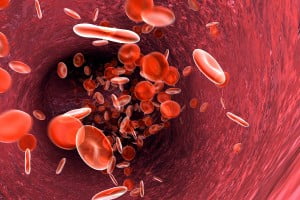A potentially groundbreaking study was for the first time able to predict a person’s suicidal tendencies with a simple blood test. The researchers found that suicidal patients have significantly higher platelet numbers than non-suicidal patients. Platelets are small clear cell fragments that are involved in the formation of blood clots.
Unlike physical illness, which can generally be identified through blood work or other biological markers, until now evaluation of most mental illnesses was possible only through patient observation.
Patient observation means a psychiatrist or other medical practitioner needs to examine the patients’ behavior and other external markers and symptoms to determine if the patient is schizophrenic, depressed, bipolar etc.
This has long been a controversial issue in the medical world, as patient observation can lead to misdiagnosis.
Related articles
- Researchers Identify Mechanism That Causes Alcoholics To Relapse
- Let’s Relax: Researchers Show Stress Leads To Increase In Autoimmune Diseases
Doctor Micha Ragolsky and his colleagues from the Beersheba Mental Health Center say that finding a pathology that expresses suicidal tendencies is paramount, especially when it comes to teenagers.
According to Ragolsky, adolescents who suffer from severe suicidal thoughts, have an up to 60 percent probability of attempting suicide within a year of declaring these thoughts.
According to the Center for Disease Control and Prevention, for youth between the ages of 10 and 24, suicide is the third leading cause of death.
Finding suicidal tendencies in the blood
 Ragolsky’s study, which began in 1995 and ended in 2004, studied a total of 108 drug-free hospitalized patients between the ages of 12 and 18.
Ragolsky’s study, which began in 1995 and ended in 2004, studied a total of 108 drug-free hospitalized patients between the ages of 12 and 18.
The control group (or complementary group, who receive no treatment) included 79 people who were randomly selected. Hospitalized patients, who suffer from schizophrenia, bipolar disorder, depression and other mental disorders, were categorized into two major groups: suicidal and non-suicidal, according to prior psychiatric examination (before the research began). Controlled individuals were all assumed to be non-suicidal.
Age, gender smoking habits and platelet count was assessed for each individual, but researchers found that it was only platelet count that seemed to matter: Suicidal patients were found to have significantly higher platelets count than the non-suicidal patients or healthy control group.
Sign up for our free weekly newsletter
SubscribeIn order to prove that the platelet count was not the result of depression, researchers compared both suicidal and non-suicidal patients suffering from depression and found that there was still a correlation between the count and suicidal tendencies.
Ragolsky tells NoCamels: “Needless to say how much such a study can influence the way mental patients are being diagnosed around the world, and how much grief it can spare a person that has been misdiagnosed. Or even to prevent long term damage to someone who has been given a drug that treats a different illness then the one he suffers from.”
No physical evidence
According to Ragolsky, one example of the errors often made by mental health practitioners is a study conducted between 1969 and 1972 by psychologist David Rosenhan. Rosenhan led a group of eight mentally healthy people into gaining admission to psychiatric hospitals by pretending to hear voices. The moment they were admitted they were told to to abandon their “symptoms” and behave the way they usually do. They spoke regularly, told their real life stories when questioned, however, the hospitals refused to release them and all of them were given powerful psychotropic drugs.
They found there’s nothing they could do to convince the doctors they were sane, and it quickly became clear that the only way out would be to agree that they were insane. Admitted with the diagnosis of paranoid schizophrenia, they were discharged with the diagnosis of paranoid schizophrenia in remission.
Predicting ups and downs
Ragolsky claims that in the following paper that will be released soon, he will demonstrate that the platelet count of a person with bipolar disorder will be able to predict whether the patient’s upcoming episode will have a manic or depressed nature.
According to the researcher, it looks like the psychological doctrine is getting closer to neuroscience and of biology. “This can only lead to more precise diagnostics, and a much finer discrimination between the mental illnesses people suffer from, and eventually to a more suitable treatment for those disorders,” Ragolsky says.
Alongside Ragolsky, the research was conducted by Dr. Hady Shimon, Dr. Hadar Shalev Dr. Abraham Weizman and Dr. Eitan Rubin.
Photos: depression teen girl cried lonely in room and Blood Cells by Bigstock
Related posts

Israeli Medical Technologies That Could Change The World

Harnessing Our Own Bodies For Side Effect-Free Weight Loss

Missing Protein Could Unlock Treatment For Aggressive Lung Cancer




Facebook comments